Terracotta, or baked clay, is a material we find in architectural decoration throughout history. It characterised buildings in ancient Greece and Rome and architects have continued to use it for centuries. As we have seen in previous posts on this blog, the Renaissance was a time of great terracotta ‘rediscovery’ first in Italy and then in Britain. Similarly, in the 19th century, great interest for this material and its potential in an industrialising construction sector, developed.
Cost efficiency, Durability, and chiaroscuro
Writing in 1868, the architect Charles Barry junior listed a number of advantages to the use of architectural terracotta. A major point was the possibility of producing architectural ornamentation, including complex sculptural elements, at a fraction of the cost of sculpted stone. Moreover, he saw important compositional advantages. It allowed trialling of the design and achievement of brilliant effects of light and shade:
Foremost among its advantages is the facility it affords to architects to see actually full size any of the more ornamental portions of their designs, in as much as the material actually built in is the same as that modelled…
Next I would like to point out the opportunity it gives for brilliant effects of light and shade…
One of the strongest arguments in favour of the use of terracotta was, however, its durability. In the polluted London environment of the mid-nineteenth century, stone surfaces on façades were decaying rapidly. The experience with the Palace of Westminster, built 1840-47 following designs by Charles Barry senior (1795-1860), had been instructive. Architects and scientists had put much effort into choosing durable materials. Despite that the stone surfaces had soon started decaying. Procuring stone that could be carved and resist the ‘acid gases the atmosphere contains’ had proved very difficult indeed. What parliament and tax payers were left with were ‘laminated surfaces, mouldering edges, and discoloration’. An immediate fiasco and a long-term problem.
Most architects, builders and cultured men agreed on the durability of terracotta. They recognised, that, although in itself a material less precious than stone, it was preferable in the London air in many respects.
On opposite sides
What experts disagreed upon, was how exactly to produce terracotta for architecture. Opinions differed both in regard to which materials to mix with the clay and which techniques to adopt for the modelling and finishing.
At a meeting of the Royal Institute of British Architects, held on 16 November 1868, a heated discussion took place. The minutes make for an interesting and entertaining reading. On the one side we have the architect Charles Barry. He was finishing building Dulwich College , which features a remarkable terracotta façade (fig. 1, below). In his support he invited to the meeting the manufacturer John Marriott Blashfield (1811–1882). He was head of the Stamford Terracotta Company and had supplied the terracotta for Dulwich College.
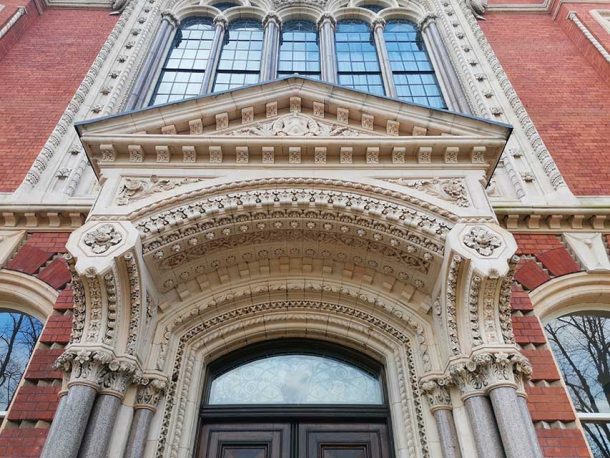
On the other side of the argument were Henry Young Darracott Scott and Gilbert Redgrave. The former, a Royal Engineer, was in charge of designing the Royal Albert Hall, at the time still a building site. The latter was the son of the more famous Richard Redgrave. He was involved in the design of many buildings in South Kensington, including what is now the V&A. (We have drawings by him of the museum building). Redgrave was in charge of overseeing the organisation, supply and use of the terracotta for the Albert Hall’s façade.
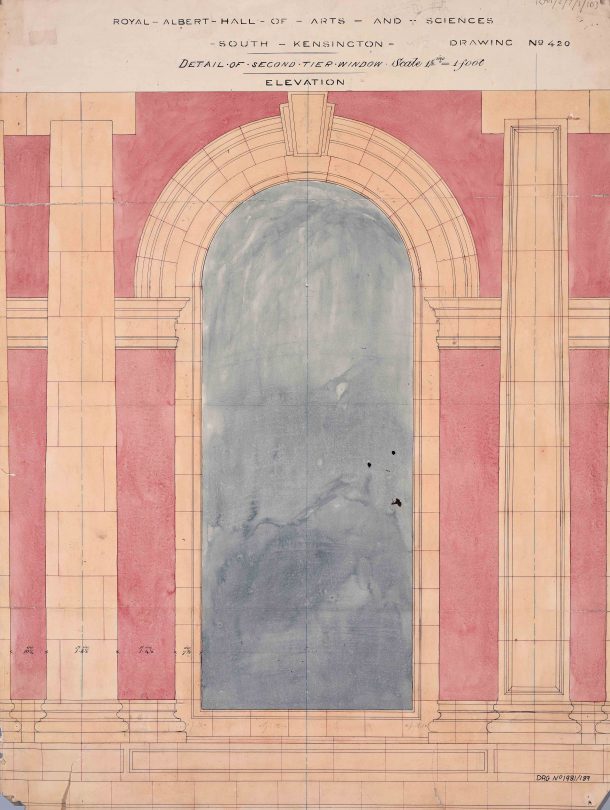
In support of Redgrave and Scott came a representative of manufacturing firm Messrs Gibbs and Canning of Tamwort. They were supplying the terracotta for the Albert Hall.
‘Sculpting’ terracotta ornamentation
The process of producing terracotta ornamentation for architecture consist of several stages. Generally, an architect designs the façade and its details. On this basis, a sculptor or the architects themselves design the moulds. In these moulds, the artisans press the raw terracotta. After drying, the terracotta is taken out of its mould and fired.
One of the points of contention in the production of terracotta in 19th century London was the degree of refinement to be given to the pieces. At Dulwich, following Barry’s directions and Blashfield’s supervision, the moulded pieces, after pressing and drying, were brought into form by masons, before being fired. More elaborate ones often even had portions carved after moulding. This led to very finely detailed pieces such as those in figure 3.
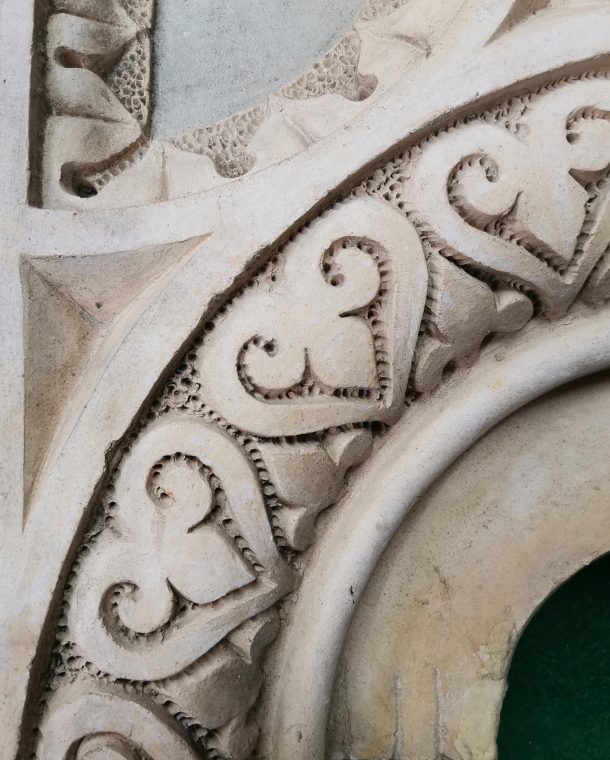
Terracotta as ‘a superior description of brick’
On the contrary, Redgrave and Scott, working on the Royal Albert Hall’s façade, believed in the artistic merits of less smooth and carefully worked surfaces. At the RIBA meeting in November 1868 mentioned above Gilbert Redgrave affirmed:
I admit most willingly the superior beauty of texture, and the biscuit-like material produced by Mr Blashfield, but I consider he attains the finish of his wares, rather at the expense of a certain vigour and artistic touch which is obtained in a coarser and rougher material at South Kensington.
In his paper to the Royal Institute of British Architects circa four years later Henry Darracott Scott reiterated the same ideas:
[At the Albert Hall] terra-cotta material was considered simply a superior description of brick, to be used in conjunction with plane surfaces of a somewhat similar material, but of another colour.
He explained that this choice had to do with the character of the building:
It was further judged that delicate modelling would be out of character with a building which must be of very massive appearance, and which should depend more for its effect on the sweep of its lines than on exquisite finish.
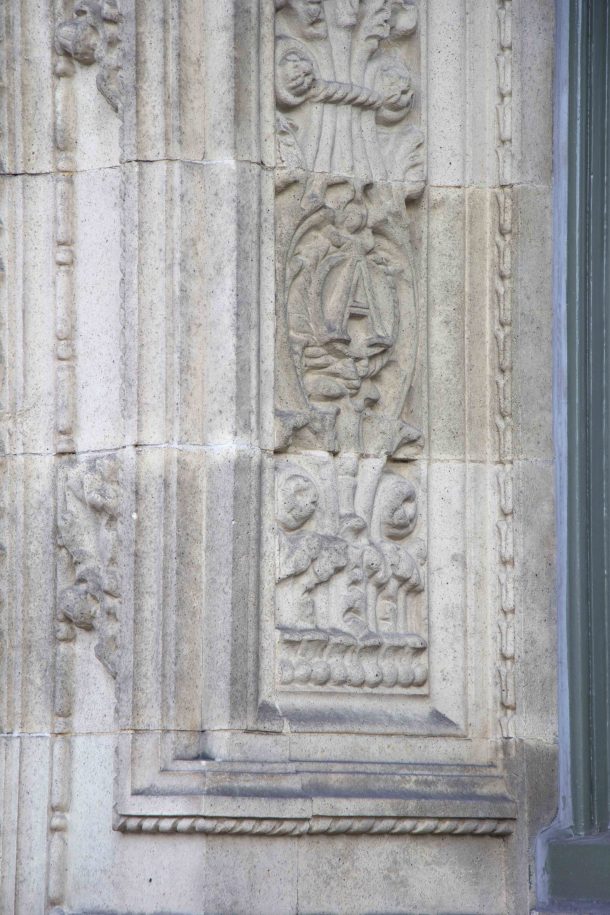
Detail of the Albert Hall’s terracotta façade (2019, Author’s photograph). Note the lack of detail in comparison with the Dulwich example.
In the two cases, it would seem, the same material was considered in different ways. In one case it was a sculpturing material, in the other a refined brick.
A question of style, a production problem
Also in South Kensington, terracotta was used in very refined ways in some buildings. For example in the Museum now known as the V&A the designers included exquisite details.
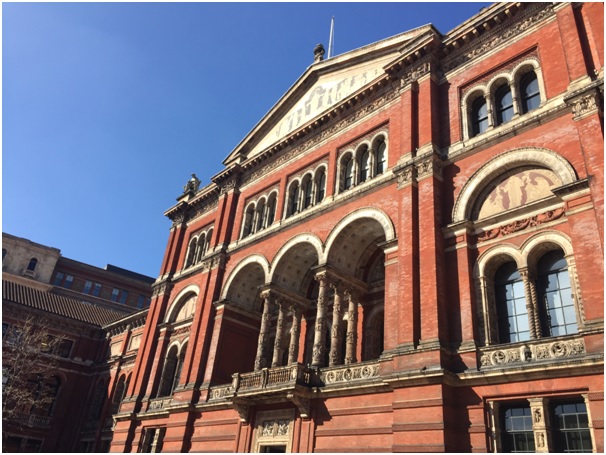
Beyond the considerations around the artistic merits of the two solutions, we must also give attention to the practical implications. While the method advocated by Scott and Redgrave lent itself more easily to serial production, at Dulwich each piece required individual attention. Thus, the two groups of designers and manufacturers were aiming at different markets and had vastly divergent visions regarding the future of terracotta as a decorative material for architecture.
If you want to know more…
This post is an outcome of the Leverhulme Trust funded Project Designing the Future: Innovation and the Construction of the Royal Albert Hall. Read the full story of the Albert Hall’s construction in the forthcoming monograph The Royal Albert Hall: Building the Arts and Sciences.
To find out more about the Royal Albert Hall’s unique characteristics and background see the other posts connected to the project. These include an ongoing series on terracotta. Watch out for the next ‘episode’ coming out in September!



A very insightful and well set forth narration of interesting developments at a significant time in architecture.
I would love to see those minutes.
I’m working on a terracotta material study. Would it be possible to have a chat?